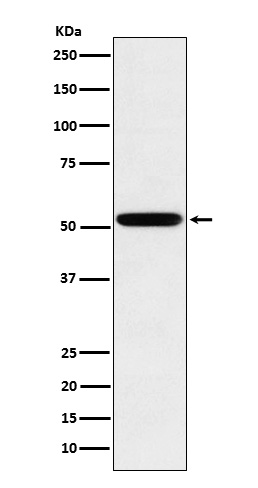
| WB | 1/1000-1/2000 | Human,Mouse,Rat |
| IF | 咨询技术 | Human,Mouse,Rat |
| IHC | IHC:1/100-1/200;IHF:1/50-1/200 | Human,Mouse,Rat |
| ICC | 1/50-1/200 | Human,Mouse,Rat |
| FCM | 咨询技术 | Human,Mouse,Rat |
| Elisa | 咨询技术 | Human,Mouse,Rat |
| Aliases | IGHG2; immunoglobulin Gm2; immunoglobulin heavy constant gamma 2 (G2m marker);;Human IgG2 |
| WB Predicted band size | Calculated MW: 36 kDa ; Observed MW: 53 kDa |
| Host/Isotype | Rabbit IgG |
| Antibody Type | Primary antibody |
| Storage | Store at 4°C short term. Aliquot and store at -20°C long term. Avoid freeze/thaw cycles. |
| Species Reactivity | Human |
| Immunogen | A synthesized peptide derived from human Human IgG2 |
| Formulation | Purified antibody in PBS with 0.05% sodium azide,0.05% BSA and 50% glycerol. |
+ +
以下是关于Human IgG2抗体的3篇参考文献及其摘要概括:
1. **"Human IgG Subclasses: Molecular Analysis of Structure, Function, and Regulation"**
*作者:Jefferis, R.*
摘要:该文献系统分析了人IgG各亚型(包括IgG2)的结构差异,重点讨论了IgG2铰链区的独特二硫键排列及其对分子柔韧性的影响,并比较了其与IgG1在补体激活和Fc受体结合能力上的差异。
2. **"Therapeutic Antibody Engineering: Current and Future Advances Driving the Strongest Growth Area in the Pharmaceutical Industry"**
*作者:Strohl, W.R.*
摘要:本文综述了抗体药物开发中IgG亚型的选择策略,指出IgG2因较低的效应功能(如ADCC/CDC)和较高的稳定性,常用于以单纯阻断靶点为主的治疗性抗体设计(如抗肿瘤坏死因子药物)。
3. **"Fcγ Receptors: Structural and Functional Aspects"**
*作者:Siberil, S. 等*
摘要:研究通过体外实验证实,IgG2与Fcγ受体(如FcγRIIa)的结合能力显著弱于IgG1.这一特性使其在自身免疫病治疗中可减少炎症副作用,但可能影响某些感染性疾病的抗体疗效。
注:以上文献信息基于领域内代表性研究主题整理,具体发表年份及细节可能需要通过PubMed或学术数据库进一步核实。如需补充更多文献,可提供更具体的需求方向(如结构、药代动力学或临床应用)。
Human IgG2 is one of the four subclasses of immunoglobulin G (IgG) in humans, alongside IgG1. IgG3. and IgG4. It constitutes approximately 20-30% of total serum IgG and plays a distinct role in adaptive immunity. Structurally, IgG2 features a unique hinge region with shorter flexibility compared to IgG1 and IgG3. along with specific disulfide bond patterns that influence its antigen-binding fragment (Fab) flexibility and Fc-mediated effector functions. These structural characteristics contribute to its restricted ability to engage Fc gamma receptors (FcγRs) and activate complement pathways, making IgG2 less potent in triggering antibody-dependent cellular cytotoxicity (ADCC) or complement-dependent cytotoxicity (CDC) compared to IgG1.
Biologically, IgG2 antibodies are often associated with responses to polysaccharide antigens, such as those found in bacterial capsules, and are predominant in immunity against encapsulated pathogens. Their limited effector functions may reduce inflammatory side effects, making IgG2 a preferred scaffold for therapeutic antibodies where minimal immune activation is desirable. For example, certain monoclonal antibody drugs targeting chronic inflammatory conditions or tumors leverage IgG2's properties to balance efficacy and tolerability.
However, IgG2's stability and long serum half-life (∼21 days) align with other IgG subclasses, supporting its therapeutic utility. Recent studies also highlight IgG2's potential in bispecific antibody engineering due to its structural adaptability. Despite its lower effector activity, IgG2 remains a critical component in both natural immune defense and biopharmaceutical applications.
×